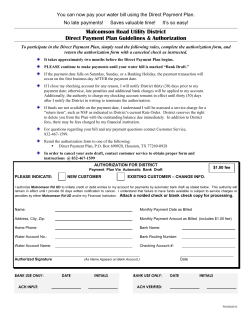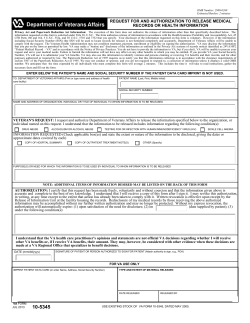
Pharmacy Medical Necessity Guidelines: Lidoderm® (lidocaine patch 5%)
Pharmacy Medical Necessity Guidelines: Lidoderm® (lidocaine patch 5%) Effective: October 15, 2013 Clinical Documentation and Prior Authorization Required √ Not Covered Pharmacy (RX) or Medical (MED) Benefit RX Type of Review – Case Management Type of Review – Clinical Review Fax: 617-673-0956 Department to Review √ RxUM Note: This pharmacy medical necessity guideline applies to commercial products. For Tufts Health Plan Medicare Preferred members, please refer to the Tufts Health Plan Medicare Preferred Prior Authorization Criteria. Background, applicable product and disclaimer information can be found on the last page. OVERVIEW FDA-Approved Indications Lidoderm (lidocaine patch 5%) is indicated for relief of pain associated with post-herpetic neuralgia. It should be applied only to intact skin. PHARMACY COVERAGE GUIDELINES Tufts Health Plan may authorize coverage of Lidoderm (lidocaine patch 5%) for Members, when the following criteria are met: 1. 2. Neuropathic pain (e.g. Post Herpetic Neuralgia) a. Failure, adverse reaction, or contraindication to gabapentin. OR Chronic (greater than 3 months) non-neuropathic pain a. Documented failure of a trial of at least two of the following drug categories being used for the treatment of non-neuropathic pain: tricyclic antidepressants, SSRI’s, SNRI’s, anticonvulsants, NSAIDs or COXII and/or opioid analgesics. Note: A trial consists of at least 30 days of each medication at therapeutic doses. OR 3. Member is new to plan and pain is currently well controlled on Lidoderm (lidocaine patch 5%). LIMITATIONS 1. Coverage of Lidoderm (lidocaine patch 5%) will be limited to 30 patches per 30 days. 2. Initial authorization for Chronic (greater than 3 months) non-neuropathic pain will be for a period of up to 3 months. Subsequent authorization for up to one (1) year will require documentation from the provider of sustained clinical effectiveness. CODES None REFERENCES 1. Davis, PS, Galer, BS. Review of lidocaine patch 5% studies in the treatment of postherpetic neuralgia. Drugs 2004; 64(9):937-47. 2. Katz NP, Gammaitoni AR, Davis MW, Dworkin RH, Lidoderm Patch Study Group. Lidocaine patch 5% reduces pain intensity and interference with quality of life in patients with postherpetic neuralgia: an effectiveness trial. Pain Med 2002 Dec; 3(4):324-32. 3. Lidoderm (lidocaine patch 5%) prescribing information. Malvern, PA: Endo Pharmaceuticals Inc.; 2013 January. APPROVAL HISTORY September 8, 2009: Reviewed by the Pharmacy and Therapeutics Committee January 1, 2010: Removal of Tufts Medicare Preferred language (separate criteria have been created specifically for Tufts Medicare Preferred) July 13, 2010: Removal of, “Tufts Health Plan will not authorize the use of Lidoderm (lidocaine patch 5%) for conditions other than those listed above without clinical justification.” And “Documented diagnosis of pain associated with post-herpetic neuralgia.” Added: Neuropathic pain: failure, adverse reaction, or contraindication to gabapentin; OR Non-neuropathic pain: failure, adverse reaction, or contraindication to two prescription analgesics (including a narcotic); OR Member is new to plan and pain is currently well controlled on Lidoderm. 2140004 1 Pharmacy Medical Necessity Guidelines: Lidoderm® (lidocaine patch 5%) July 12, 2011: No changes November 15, 2011: Removed the criteria for non-neuropathic pain which required failure, adverse reaction, or contraindication to two prescription analgesics (including a narcotic); and replaced it with Chronic (greater than 3 months) non-neurpathic pain “Documented failure of a trial of at least two of the following drug categories being used for the treatment of non-neuropathic pain: tricyclic antidepressants, SSRI’s, SNRI’s, anticonvulsants, NSAIDs or COXII and/or opioid analgesics.” Added a note: A trial consists of at least 30 days of each medication at therapeutic doses. Added limitation: Initial authorization for non-neuropathic pain will be for a period of up to 3 months. Subsequent authorization for up to one (1) year will require documentation from the provider of sustained clinical effectiveness. October 9, 2012: No changes October 15, 2013: No changes BACKGROUND, PRODUCT AND DISCLAIMER INFORMATION Pharmacy Medical Necessity Guidelines have been developed for determining coverage for Tufts Health Plan benefits and are published to provide a better understanding of the basis upon which coverage decisions are made. They are used in conjunction with a Member’s benefit document and in coordination with the Member’s physician(s). Tufts Health Plan makes coverage decisions on a case-by-case basis considering the individual Member's health care needs. Pharmacy Medical Necessity Guidelines are developed for selected therapeutic classes or drugs found to be safe, but proven to be effective in a limited, defined population of patients or clinical circumstances. They include concise clinical coverage criteria based on current literature review, consultation with practicing physicians in the Tufts Health Plan service area who are medical experts in the particular field, FDA and other government agency policies, and standards adopted by national accreditation organizations. Tufts Health Plan revises and updates Pharmacy Medical Necessity Guidelines annually, or more frequently if new evidence becomes available that suggests needed revisions. Pharmacy Medical Necessity Guidelines apply to all fully insured Tufts Health Plan offerings unless otherwise noted in this policy or the Member’s benefit document. Check the applicable formulary in the Pharmacy section of our website at www.tuftshealthplan.com/providers to determine if the drug requires you to get prior authorization. This Pharmacy Medical Necessity Guideline does not apply to Uniformed Services Family Health Plan Members or to certain delegated service arrangements. Unless otherwise noted in the Member’s benefit document or applicable Pharmacy Medical Necessity Guideline, Pharmacy Medical Necessity Guidelines do not apply to CareLink SM Members. For self-insured plans, drug coverage may vary depending on the terms of the benefit document. If a discrepancy exists between a coverage guideline and a self-insured Member’s benefit document, the provisions of the benefit document will govern. Applicable state or federal mandates will take precedence. For Tufts Health Plan Medicare Preferred, please refer to Tufts Health Plan Medicare Preferred Prior Authorization Criteria. Treating providers are solely responsible for the medical advice and treatment of Members. The use of this policy is not a guarantee of payment or a final prediction of how specific claim(s) will be adjudicated. Claims payment is subject to Member eligibility and benefits on the date of service, coordination of benefits, referral/authorization and utilization management guidelines when applicable, and adherence to plan policies and procedures and claims editing logic. Provider Services 2 Pharmacy Medical Necessity Guidelines: Lidoderm® (lidocaine patch 5%)
© Copyright 2025





















